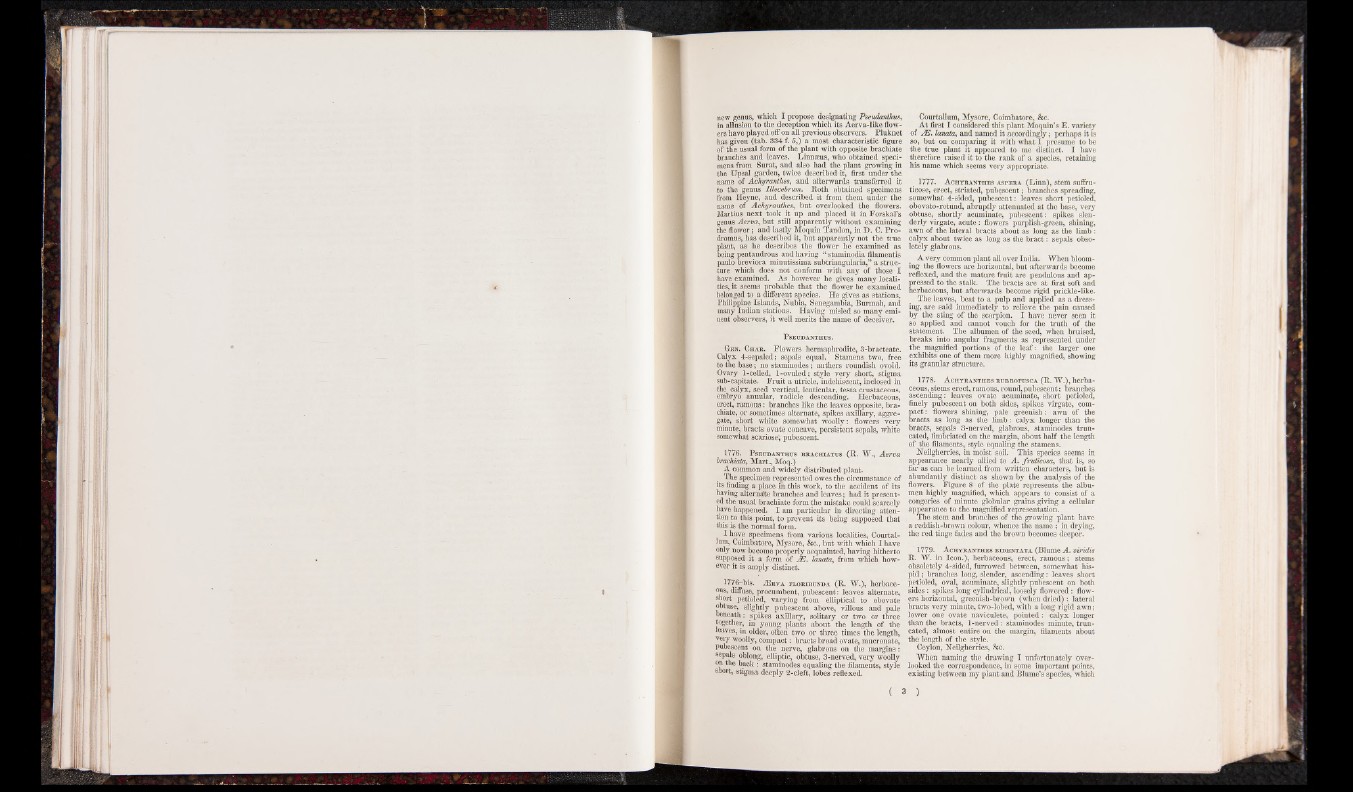
new genus, Which I propose designating Pseudanihus,
in allusion to the deception which its Aerva-like flowers
have played off on all previous observers. Pluknet
has given (tab. 334 f. 5,) a most characteristic figure
of the usual form of the plant with opposite brachiate
branches and leaves. Linnaeus, who obtained specimens
from Surat, and also had the plant growing in
the Upsal garden* twice described it, first under the
name of Achyranthes, and afterwards transferred it
to the genus fflecebrum. Roth obtained specimens
from Heyne, and described it from them under the
name of Achyranthes, but overlooked the flowers.
Martius next took it up and placed it in Forskal’s
genus Aervff, but still apparently without examining
the flower; and lastly Moquin Tandon, in D. C. Pro-
dromus, has described it, but apparently not the true
plant, as he describes the flower he examined as
being pentandrous and having “ staminodia filamentis
paulo breviora minutissima subtriangularia,” a structure
which does not conform with any of those I
have examined. As however he gives many localities,
it seems probable that the flower he examined
belonged to a different species. He gives as stations,
Philippine Islands, Nubia, Senegambia, Burmah, and
many Indian stations. Having misled so many eminent
observers, it well merits the name of deceiver.
P seud anthus.
Gen. Char. Flowers hermaphrodite, 3-bracteate.
Calyx 4-sepaled; sepals equal. Stamens two, free
to the base; no staminodes; anthers roundish ovoid.
Ovary 1-celled, 1-ovuled; style very short, stigma
sub-capitate. Fruit a utricle, indehiscent, inclosed in
the calyx, seed vertical, lenticular, testa crustaceous,
embryo anuular, radicle descending. Herbaceous,
erect, ramous: branches like the leaves opposite, brachiate,
or sometimes alternate, spikes axillary, aggregate,
short white somewhat woolly: flowers very
minute, bracts ovate concave, persistent sepals, white
somewhat scariose} pubescent.
1776. Pseudanthus brachiatus (R. W., Aerva
brachiata, Mart., Moq.)
A common and widely distributed plant.
The specimen represented owes the circumstance of
its finding a place in this work, to the accident of its
having alternate branches and leaves; had it presented
the usual brachiate form the mistake could scarcely
have happened. I am particular in directing attention
to this point, to prevent its being supposed that
this is the normal form.
I have specimens from various localities, Courtal-
lum, Coimbatore, Mysore, &c., but with which I have
only now become properly acquainted, having hitherto
supposed it a form of 2E. lanata, from which however
it is amply distinct.
1776-bis. JErva fdoribunda (R. W .), herbace-
ous, diffuse, procumbent, pubescent: leaves alternate,
short petioled, varying from elliptical to obovate
obtuse, slightly pubescent above, villous and pale
beneath: spikes axillary, solitary or two or three
together, in young plants about the length of the
leaves, in older, often two or three times the length,
very woolly, compact: bracts broad ovate, mucronate,
pubescent on the nerve, glabrous on the margins:
sepals oblong, elliptic, obtuse, 3-nerved, very woolly
on the b ack: staminodes equaling the filaments, style
short, stigma deeply 2-cleft, lobes reflexed.
Courtalium, Mysore, Coimbatore, &c.
At first I considered this plant Moquin’s E. variety
of AH. lanata, and named it accordingly; perhaps it is
so, but on comparing it with what I presume to be
the true plant it appeared to me distinct. I have
therefore raised it to the rank of a species, retaining
his name which seems very appropriate.
1777. Achyranthes aspera (Linn), stem suflru-
ticose, erect, striated, pubescent: branches spreading,
somewhat 4-sided, pubescent: leaves short petioled,
obovato-rotund, abruptly attenuated at the base, very
obtuse, shortly acuminate, pubescent: spikes slenderly
virgate, acute: flowers purplish-green, shining,
awn of the lateral bracts about as long as the limb :
calyx about twice as long as the b ra c t: sepals obso-
letely glabrous.
A Very common plant all over India. When blooming
the flowers are horizontal, but afterwards become
reflexed, and the mature fruit are pendulous and ap-
pressed to the stalk. The bracts are at first soft and
herbaceous, but afterwards become rigid prickle-like.
The leaves, beat to a pulp and applied as a dressing,
are said immediately to relieve the pain caused
by the sting of the scorpion. I have never seen it
so applied and cannot vouch for the truth of the
statement. The albumen of the seed, when bruised,
breaks into angular fragments as represented under
the magnified portions of the leaf: the larger one
exhibits one of them more highly magnified, showing
its granular structure.
1778. Achyranthes rubrofusca (R. W .), herbaceous,
stems erect, ramous, round, pubescent; branches
ascending: leaves ovate acuminate, short petioled,
finely pubescent on both sides, spikes virgate, compact
: flowers shining, pale greenish: awn of the
bracts as long as the limb: calyx longer than the
bracts, sepals 3-nerved, glabrous, staminodes truncated,
fimbriated on the margin, about half the length
of the filaments, style equaling the stamens.
Neilgherries, in moist soil. This species seems in
appearance nearly allied to A . frwticosa, that is, so
far as can be learned from written characters, but is
abundantly distinct as shown by the analysis of the
flowers. Figure 8 of the plate represents the albumen
highly magnified, which appears to consist of a
congeries of minute globular grains giving a cellular
appearance to the magnified x*epresentation.
The stem and branches of the growing plant have
a reddish-brown colour, whence the name; in drying,
the red tinge fades and the brown becomes deeper.
1779. Achyranthes bidentata (Blume A . viridis
R. W. in Icon.), herbaceous, erect, ramous; stems
obsoletely 4-sided, furrowed between, somewhat hispid
; branches long, slender, ascending: leaves short
petioled, oval, acuminate, slightly pubescent on both
sides: spikes long cylindrical, loosely flowered: flowers
horizontal, greenish-brown (when dried) : lateral
bracts very minute, two-lobed, with a long rigid awn;
lower one ovate naviculete, pointed: calyx longer
than the bracts, 1-nerved: staminodes minute, truncated,
almost entire on the margin, filaments about
the length of the style.
Ceylon, Neilgherries, &c.
When naming the drawing I unfortunately overlooked
the correspondence, in some important points,
existing between my plant and Blume’s species, which